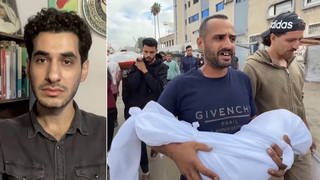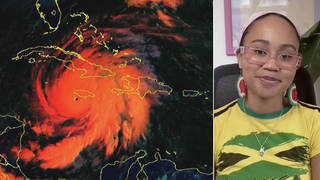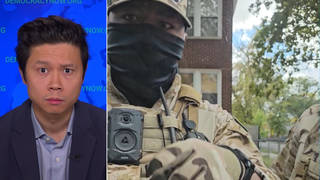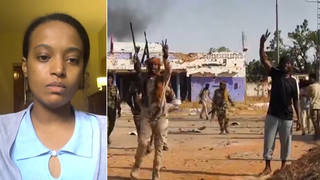
An extended conversation with Pua Case, an indigenous organizer and activist who is fighting the construction of the Thirty Meter Telescope atop Mauna Kea, a mountain sacred to Native Hawaiians. The project has the backing of Canada, China, India, Japan and the United States, as well as institutional funders. If built, the Thirty Meter Telescope would be capable of capturing images 12 times sharper than those from the Hubble Space Telescope. Although Mauna Kea was approved as the site of the telescope in 2009, repeated protests and legal challenges have delayed construction. Indigenous protesters, known as protectors, say they were not adequately consulted before the sacred mountain was chosen for the billion-dollar project, and that it comes with serious environmental risks.
“We are not anti-science,” Case says. “We are against the building of anything 18 stories over our watershed, water aquifers, on our sacred mountain. It could have been anything; it just happens to be a telescope.”
Transcript
AMY GOODMAN: This is Democracy Now!, democracynow.org, The War and Peace Report. I’m Amy Goodman, as we continue to look at the historic indigenous resistance unfolding on the Big Island in Hawaii, where thousands have descended on Mauna Kea—a sacred Native site, the tallest mountain in the world—they say, to defend it from the construction of a $1.4 billion massive telescope called the TMT, or the Thirty Meter Telescope. Scientists say the telescope will help them peer into the deepest corners of space. But indigenous resisters say the construction was approved without their consent and will desecrate their sacred lands.
Last week, police arrested 33 people, most of them Hawaiian elders, as they blocked a road to prevent work crews from reaching the site of the Thirty Meter Telescope being planned atop Mauna Kea. This is an indigenous protester speaking from the sacred site last week.
HAWAIIAN ELDER: So, we’re here to stop the desecration of our Mauna, our life actually. This is our land. This is where we live, and this is where we’re going to die.
AMY GOODMAN: On Sunday, even more demonstrators gathered at the access road to thwart construction. Activists report it may have been 1,000-2,000 people who are at the site fighting back against the proposed construction.
For more, we’re going to Mauna Kea to continue our conversation with Pua Case, an indigenous organizer and activist defending the sacred Hawaiian site. She is joining us via Skype in the very early hours of the morning, about 3 a.m. on the Big Island.
Pua, you have been traveling the world warning about the TMT, certainly before most people in the world even knew what this was, the Thirty Meter Telescope. Can you explain how it came into being, the hundreds of millions of dollars that has been promised to Caltech and the University of California to build this telescope, the foundation—from the money of the founder of Intel, the corporation? Explain when you got involved.
PUA CASE: Sure. My family were—we were the last petitioners who entered the contested case hearings in 2010. There were five petitioners entered into the case. When there is a project of any magnitude, it goes in front of the Board of Land and Natural Resources. And before they render a decision, you can enter a request to be a contested case petitioner to contest if an approval is given on a project that you don’t agree with. So, there were five petitioners who have been standing for the mountain for over 20 years, and they had filed to be petitioners in a contested case, should an approval be granted by the board.
So, my family was—we were prompted. And I’m going to say this, because indigenous people are listening everywhere, and you understand. We were prompted by the mountain herself to try to stop the telescope, because it would change everything on the mountain, which is the way it was described to us. The climate, the amount of water, the wind direction—everything would change with such a massive structure. And that’s not so hard to believe; of course it would be impacted in that way. So, we became the sixth petitioner.
And we went through two contested cases and two Supreme Court hearings, from 2010 all the way until now, 2019. And so, when the permit was upheld in the Hawaii Supreme Court, even though the permit must meet eight criteria in order to build in a conservation zone—and the permit could never meet all eight criteria—however, the permit just was passed along and approved anyway, through the system that we have here. So, what you are looking at, when you see the police and the number of armed forces, is that they are standing to prevent us from protecting our mountain, based on a permit that should never have been granted. So, it makes it even sadder for us that our people must defend a permit that could not meet the eight criteria to build.
So, for 10 years now, which is part of the reason that this is such an incredible stance, when you look at it from a world view, we have been able to hold off the building of this massive telescope on our mountain for 10 years by five countries. And I think that that’s pretty incredible and also symbolic and an inspiration for people who are standing for whatever it is that they hold dear, be it their sacred places. I believe that we are a symbol of hope for them. And so, we are going to do our very, very best, because we are committed that this project will never see the light of day on our sacred mountain.
AMY GOODMAN: You know, when the standoff at Standing Rock took place, it was in the midst of the presidential campaign of 2016. And even as it intensified and thousands of people came to North Dakota to protest the Dakota Access pipeline, it was not raised in any debate. Actually, interestingly enough, in the general debates in 2016, not one of the moderators even raised a question about climate change. But it may enter this debate, because one of those who is running for president has taken a stand on this, and that’s your Hawaii representative, Democratic presidential candidate, Congressmember Tulsi Gabbard, who issued a statement about the protest at Mauna Kea on Friday. I want to play what she said.
REP. TULSI GABBARD: The materialistic way that developers and corporations are viewing Mauna Kea—ignoring the spiritual significance and relationship that many Native Hawaiians have with the Mauna—is really what is at the heart of the problem. It’s hypocritical that many TMT proponents speak of their own spiritual quest for knowledge and wisdom, while simultaneously closing their eyes to the spiritual inspiration and significance that Mauna Kea offers, not only to Native Hawaiians, but to humanity at large. …
Trust is earned. And it’s wrong that state leaders have approved development of a new telescope on a new site on Mauna Kea without first ensuring the timely removal of decommissioned facilities, along with the full restoration of those sites. This failure and a history of broken promises is what’s resulted in the standoff that we are seeing today, and the lack of trust that government promises now to respect the ’aina and our sacred places will actually be kept.
AMY GOODMAN: So, that’s Hawaii congressmember, now Democratic presidential candidate, Tulsi Gabbard, weighing in on this TMT, the Thirty Meter Telescope. Pua Case, can you respond to what she said?
PUA CASE: You know, this is the first time I’m hearing this, because up here in the mountain, social media and news is limited, and many of us are working 24/7. We don’t get the chance to view all of the actions that are happening around the world on our behalf, or statements like that.
So, to Tulsi Gabbard, I’m actually—I’m not surprised by it, I’m thrilled by it. I’m so happy that she put that statement out. I would like to see and ask her to help us to resolve this. You know, that’s what I would like to see come out of this statement. But what she is saying is very accurate, in all the statements that she’s making, so I’m very happy with that. And I’d like to see a next step occur, because the last thing we want to have here, Amy, is our people getting hurt, further arrests and getting hurt, especially with the deployment of the emergency proclamation. This gives the governor more access to law enforcement and, yes, to the National Guard. So I’m making my plea out to Tulsi: Let’s take the next step and help us to resolve this.
AMY GOODMAN: So, if you can talk about something you started in Part 1 of the conversation, just the significance of Mauna Kea, the largest mountain from the very base under the—under the earth to the top, and also of what is being proposed? I mean, again, you have the Gordon and Betty Moore Foundation giving $200 million to California Institute of Technology and University of California to the construction of this. And, of course, Gordon Moore, the co-founder of Intel Corporation. The telescope would be one of the largest in the world, featuring adaptive optics that would see it rival the Hubble Space Telescope in terms of angular resolution. It could study exoplanets, planets around other stars, peer to the edge of the observable universe to unlock some of the mysteries of the cosmos. If you can talk about that and the other telescopes around it that have been built there? This one would be the, obviously, largest and most significant one. And could you see anything being built there? Do you think this involves simply the fact that you weren’t—that the indigenous people were not consulted? Or are you opposed to all of it?
PUA CASE: You know, you just asked me a lot of questions there, Amy, at 3:30 in the morning, and I’m not sure I’m going to be able to answer all of—all of what you just asked me. So I’m going to perhaps try to summarize that in several statements.
I’m going to start with the fact that, as Native Hawaiians, we are not anti-science. It’s not culture versus science. We are against the building of anything 18 stories over our watershed, water aquifers, on our sacred mountain. It could have been anything; it just happens to be a telescope.
They have a second site in the Canary Islands, which I will say, honestly, I’m not advocating for that, because I’m not sure how the Native people feel about it being moved to the islands there. And I would like to know how they feel before I advocate for that, because we have said that we will stand with them if they are against building it there, as well.
So, having said that, the desecration, the construction—just imagine how much destruction it will take to build something that massive on the mountain. Furthermore, when we speak about decommissioning as a mediating factor, perhaps if they decommission three or four, and try—which is not possible—to return the earth and the mountain, they have shaved off the top of that mountain long time ago. You cannot return that mountain to its pristine state. The new telescope, should it, would it, if it would have ever been built, which it will not, would be on a pristine area, which decommissioning telescopes on the summit would not have any kind of impact on that.
We only have one sacred mountain left in terms of Mauna Kea. That is the home of our Wao Akua, our deities, that is our genealogical-linked. They can go somewhere else. We are not going anywhere else. And that is the plea of Native people around the world.
I personally am not against science, but I am against science that will destroy our land base. So what I’m saying to Gordon and Betty Moore and other funders is, let’s work together to make sure that in the quest of science and knowledge, we are not destroying Native peoples’ land basis, life ways and water sources in the process, as if it didn’t matter, as if they have a right to it, as if we, as Native people, are supposed to, in the name of science, economy, corporations and business, supposed to just lay down and allow that to happen.
This is a time when we must be brave and we must be sure. And we must stand, because this is all that we have left. And if we cannot protect the sacred, then what is going to be left for the next seven generations? We must ensure our children and show them that when we say we take care of the Earth and the environment, that we really will do that. What they will lose when they cannot build here is nowhere comparable to what we have already lost and what we stand to lose if they build on our mountain.
Our mountain is a symbol of unity for the entire world. It is a symbol of how to stand when you must protect the sacred, protect your world that you live in, protect your resources and your source and your life ways. And why people can’t understand that, I can’t fathom it.
AMY GOODMAN: Can you explain what Kapu Aloha is, Pua?
PUA CASE: Kapu Aloha is a term of our people. It’s a traditional term. And in essence, it means sacred mountain or sacred environment, sacred conduct. So, here on the mountain, what it ensures is that when we are gathered, when we are standing and when we make the commitment to protect the mountain, we stand in Kapu Aloha. We stand in sacred mountain, because—sacred conduct, because the mountain is sacred.
What that does for us is it gives us guiding principles and a code of conduct for all who come into the space to help us to stand, to assist in standing in any way. So, Kapu Aloha is kind of like the law of the land here. It means that we stand in a ceremonial stance, because we understand that the way of standing in the past, where we stood in anger, where we stood in outrage, won’t serve us this time, because we have children who are witnessing and participating in the stance. And if we stand in a way that is filled with anger and rage, that’s what they’re going to see. And they’re not going to—they’re going to be discouraged from standing, because they’re going to say to us, “You are always angry. You are always depressed. When we lose, you’re always sad. And it impacts us on every level.”
So, instead, we’ve had to turn it to how we stand is in prayer. We stand in chant, our language, our dances, perhaps in silence. We stand in a manner that the kupuna, or the elders, request of us, some of us, as they were arrested, asked us to stand in complete silence, which was difficult for us. But it was their moment to make their stance. Some of them asked us to chant or to sing with them. But the manner in which you stand is in total self-discipline.
So, you can see that Mauna Kea is training us to stand for more than the mountain. Amy, I’m listening to your program, and I can tell you that many of the issues that you discuss on your program, we have right here in Hawaii, from the use of pesticides to GMO, to expansion of the military, to geothermal. We have everything that is occurring in other places, except we are the size of a pinhead, you know, so everything is so concentrated here. So the mountain is training us to stand in the way that we will need to stand, in passive resistance, but fierce in the love of our land.
AMY GOODMAN: Well, clearly, Pua, it is not the indigenous people versus the scientists, because I’m looking at an open letter being circulated among astronomers and astrophysicists that reads, in part, “We call upon the astronomy community to recognize the broader historical context of this conflict, and to denounce the criminalization of the protectors on Maunakea. We urge the TMT collaboration and the government of Hawaii to desist from further arresting or charging protectors, and to remove military and law enforcement personnel from the summit.” And that has been signed by over—it has over 750 signatures on it at this point. Can you talk about the other solidarity actions that are taking place? In Part 1, we talked about those standing up at Standing Rock this weekend in solidarity with indigenous Hawaiian activists and nonindigenous, who have come to support you. And now we see this letter from the scientists. What other things are happening around the United States and the world around Mauna Kea?
PUA CASE: We started a petition, a worldwide petition, that just this week, with our supporters and dear, dear friends in the United Kingdom, that we had a goal of 100,000 signatures to be delivered to the Gordon and Betty Moore Foundation this Wednesday or sometime this week. And I’m so happy to report that we have made it well past 100,000. So now we’re going for 2,000 signatures. So that’s just one action.
AMY GOODMAN: Two hundred thousand?
PUA CASE: Yes. So, we’ve passed our own goal of over 100,000. So we’re trying to get to 200,000. And the reason that that petition is so important is because every time prior to this when we’re portrayed in the media, it always said some Hawaiians and their supporters are against the building of the Thirty Meter Telescope. And what we wanted to show is that we are far more than “some Hawaiians and their supporters.”
So, although we are not aware of all of the actions, like I said, through limited social media, we do know that people in the Pacific, our Polynesian relatives, are standing for us everywhere. And people around the world and on the continent have actions of their own.
So what we are saying to those who are organizing actions is, when you organize an action on behalf of Mauna Kea, it is as if you are on the mountain. So, please, make sure that all actions are aligned with Kapu Aloha in integrity, in self-discipline, in respect, no matter what the action is, because every time an action is done in our name, it is done as a Mauna Kea movement event. And so, we are just urging everyone to make sure, if you are calling the Gordon and Betty Moore Foundation, if you are calling all of the partners, which we really urge you to continue to do, because we believe that how we will be successful is for them to withdraw from the project—so, if you are calling them, please present your telephone call in a positive manner, as we do here. We are here to protect a mountain. We are here to do that in the most positive and best way that we can, without harming ourselves or others in any way. So, that’s what I would say to everyone who are praying for us.
AMY GOODMAN: And finally, Pua, the—
PUA CASE: Thank you. Yes.
AMY GOODMAN: —Hawaii County Council planning to vote on the resolution, “strongly urging” Governor Ige and Mayor Harry Kim to honor a request for a 60-day moratorium on construction, is this what you are supporting? You also—Mayor Harry Kim has expressed support—is that right?—for this indigenous action.
PUA CASE: He has, after coming here and going through where we are staying, and viewing how we are organized. I mean, we have recycling. We have compost. We have everything in place that we can. We improve every day. And we invited him to come and view the camp, especially after Governor Ige’s comments, which he did, and, yes, he came and addressed us all and really told us that we have a right to be here and to make this stance for Mauna Kea.
As far as the moratorium by the County Council, that is not the only action. We have some pending lawsuits that are also going to be heard this week, the temporary restraining orders. We are doing what we can to ensure that this project will halt. What would be even better than moratoriums and temporary restraining orders is just to have the TMT corporation, TIO, withdraw from the project today.
AMY GOODMAN: Well, I want to thank you so much for being with us, Pua Case. We are speaking, at your time, very, very early in the morning, around 3:30 in the morning. You are at that base at the access road, that is where the equipment has to pass through and the builders have to pass through to go to the mountain, as indigenous people in the place you are in are trying to stop that building from taking place. Pua Case, indigenous organizer, activist defending Hawaii’s Mauna Kea. We want to thank you very much for being with us, and let people know you can go to Part 1 of our conversation with Pua at democracynow.org. I’m Amy Goodman. Thanks so much for joining us.











Media Options